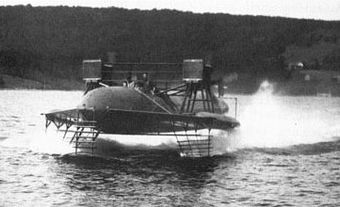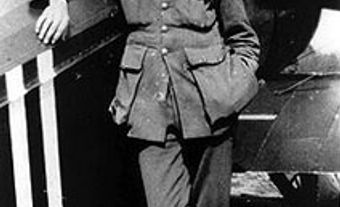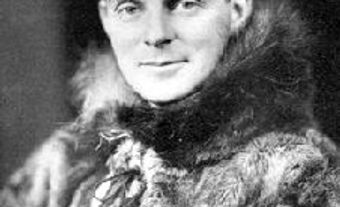Ian Willoughby Bazalgette, VC, DFC, pilot and master bomber (born 19 October 1918 in Calgary, Alberta; died 4 August 1944 near Senantes, France). Bazalgette died after his plane was hit during a bombing mission over occupied France during the Second World War. He was posthumously awarded a Victoria Cross (VC) in August 1945.

Ian Bazalgette (wearing the ribbon of his DFC) signed this portrait for his grandfather.
(courtesy Bomber Command Museum of Canada)
Early Life
Ian Bazalgette was the son of Charles and Marion Bazalgette. His father was born in Wimbledon, a suburb of London, England, and served in the British forces for four years. He immigrated to Canada in 1910 with his wife and two children and became a farmer in Hardisty, Alberta. Charles Bazalgette joined the Canadian Expeditionary Force in 1915 and served in France. He was discharged as unfit for further service in 1917 due to several medical problems and moved to Calgary the following year.
When Ian Bazalgette was five years old, his family moved to Toronto, where he received his early education at Balmy Beach School. In 1927, the family moved to New Malden, England, near Wimbledon. Bazalgette attended Rokeby School from 1927 to 1932 and Beverley Boys’ School (now Coombe Boys’ School), where he completed his schooling.
As a child, Bazalgette suffered from poor health. At 13 years of age, he was diagnosed with tuberculosis. He was admitted to a sanatorium, followed by four months of treatment at the Royal Sea Bathing Hospital in Margate.
War Service
Ian Bazalgette enrolled in the Royal Artillery in July 1939 and was commissioned second lieutenant in 1940. He served with an artillery searchlight unit in Scotland and then transferred to the Royal Air Force Volunteer Reserve in June 1941. He began his flight training at 22 Elementary Flying Training School in Cambridge. Bazalgette completed his initial flying training at RAF Cranwell, Lincolnshire, on 24 January 1942 and was promoted to pilot officer.

A Lancaster from Ian Bazalgette's 635 Squadron participates in a daylight raid on a railway marshalling yard.
(courtesy Bomber Command Museum of Canada)
Bomber Command
Ian Bazalgette was posted to 25 Operational Training Unit, where final training occurred before being sent to a frontline unit. By September 1942, he had joined No. 115 Squadron, which flew Vickers Wellington III bombers from bases in East Anglia. Among Bazalgette’s first missions were “gardening” sorties, which involved laying mines in the North Sea off the German coast. A sortie is a combat mission by a single aircraft. He was promoted to flying officer in October. After flying 13 operations, Bazalgette trained on the Avro Lancaster II, the new bomber that had replaced the squadron’s Wellingtons.
Bazalgette flew the Lancaster on 10 successful bombing raids against heavily defended targets in Europe. He survived these harrowing experiences, as well as a crash landing. On 29 May 1943, he was awarded the Distinguished Flying Cross (DFC). The citation noted his “great courage and determination in the face of the enemy.” In September, he was promoted to flight lieutenant.
After completing his first “tour” of 28 missions, Bazalgette was posted to a training unit at RAF Lossiemouth, Scotland, where he was an instructor and a flight commander. He was then accepted into the elite No. 8 (Pathfinder Force) Group in April 1944. Pathfinder crews had proven to have exceptional abilities in aerial navigation. They flew ahead of the main bomber force on missions and marked their targets with various coloured flares. Bazalgette was posted to No. 635 Squadron at RAF Downham Market, Norfolk.
After Bazalgette completed his conversion training, he became an acting squadron leader. He flew several missions before and during the D-Day and Normandy campaign. He was also appointed master bomber. Master bombers circled above the target and directed the bomber stream by radio. This made them stand out from other bombers as they dropped their bombs. It also made them open to radio interception and attack by German fighters.
In late June, Bazalgette became part of Operation Crossbow, the Allied campaign to destroy Germany’s V-1 Flying Bombs. The Germans began launching V-1s against London, England, on 13 June 1944 — about a week after D-Day. The flying bombs (forerunners of the modern cruise missile) caused more than 30,000 British casualties by the end of the Second World War.

In Len Krenzier’s painting "Beyond Praise," Ian Bazalgette's Lancaster bomber flies low over the village church in Senantes, France, before crash landing in a nearby field.
(courtesy Bomber Command Museum of Canada)
Heroism in the Air
On his 58th mission on 4 August 1944, Ian Bazalgette was master bomber for a daylight raid against V-1 rocket storage caves at Trossy St. Maximin, France, 40 km north of Paris. As he neared the target, his Lancaster bomber came under heavy anti-aircraft fire. Both starboard engines were knocked out, and a serious fire started. Two other master bombers had already been shot down, leaving Bazalgette next to mark the target.
Bazalgette pressed on, accurately marking and bombing the target. After he dropped his bombs, his aircraft went into a spin, nearly out of control. Just as he managed to regain control of his bomber, the inner port engine failed and the starboard wing was aflame. Bazalgette ordered his crew to bail out as he searched for a place to land safely. Four crewmen parachuted to safety and evaded capture by the Germans, but two wounded ones could not. Bazalgette managed to land his bomber safely near Senantes, but it exploded immediately, killing him and the other two crewmen aboard.
Local civilians retrieved Bazalgette’s remains and hid them until Allied forces arrived and liberated the area. On 8 October 1944, his body was laid to rest at a ceremony in the Senantes churchyard, which was attended by his sister. When the four surviving aircrew told the story of Bazalgette’s heroism, he was immediately recommended for a posthumous Victoria Cross. It was authorized on 17 August 1945.

The Ian Bazalgette Memorial Lancaster was restored by members of the Bomber Command Museum of Canada, Nanton, Alberta, in the colours and markings of Bazalgette's bomber.
(courtesy Bomber Command Museum of Canada)
Memory
Ian Bazalgette’s medals are held by the Royal Air Force Museum in London. A garden in New Malden is named after him, and memorials to him stand outside the church of St. Mary’s in Bexwell, close to where RAF Downham Market was formerly located, and the church of St. Mary’s in Wimbledon. There is a memorial at the crash site near Senantes, France (1994). At the Bomber Command Museum of Canada in Nanton, Alberta, a memorial Lancaster bomber FM-159 is painted in the markings of Bazalgette’s aircraft (1990). The town of Nanton and the village of Senantes were twinned in 2009. There is a Mount Bazalgette (1949) in Jasper National Park in Alberta and Ian Bazalgette School in Calgary (1967). Bazalgette was inducted into Canada’s Aviation Hall of Fame in 1974.

 Share on Facebook
Share on Facebook Share on X
Share on X Share by Email
Share by Email Share on Google Classroom
Share on Google Classroom


